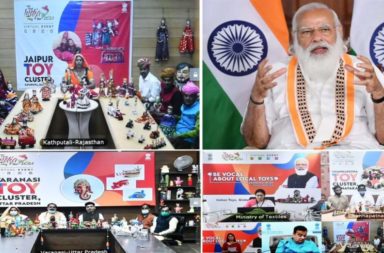Renewable energy such as biogas and solar energy have changed the lives of villagers in Jharkhand. With solar panels and biogas plants set up as part of UNDP’s Renewable Energy for Rural Livelihoods project, villages not only have access to much-needed electricity, but also to more employment opportunities and clean energy for cooking purposes.
Pano a resident of Chora, became the owner of a biogas plant, which converts waste organic matter such as cow dung and dead leaves into biogas for cooking. The use of renewable energy such as biogas and solar energy has changed Pano’s daily life considerably, as it has altered the life of people in Chora, a village in the interiors of Jharkhand. The village is one of 34 where UNDP’s Renewable Energy for Rural Livelihoods project is being implemented. This project reaches out to the inhabitants of remote villages in the states of Jharkhand, Uttarkhand, Rajasthan and Sikkim, and promotes renewable energy to improve lives and provide livelihood activities.
Solar panels on thatched roof tops in Chora are an interesting sight and provide much-needed electricity to the village households. Solar panels also power the village street lights. Before they were installed, there was no electricity in the village and the villagers were dependent on kerosene lanterns. As dusk falls now, children in Chora gather around the village street lights to do their homework. “The solar energy has helped my daughter study in the evenings for her exams,” says Vimla, a member of the local women’s self help group.
Vimla is also busy leading her self help group members in livelihood activities that use renewable energy. “We use the electricity from the gasifier to grind rice. This has helped us to earn money,” declares Vimla. The gasifier is a machine that converts biomass into clean gaseous fuel and produce electricity. “Earlier women (of the self help group) didn’t want to get involved (in the rice grinding activity) but now they participate actively (in the self help group),” adds Vimla. Women from Vimla’s group save the money earned from grinding the rice to educate their daughters. Rajesh, a farmer, uses the gasifier for another purpose. “We use the electricity to make briquettes (from waste wood), which we sell to the factory nearby. This helps me a lot, as I don’t have to go far for work and I can stay in the village to look after my fields and family.” The briquettes are used by the factory in their furnaces.
To ensure that market opportunities are available to villagers like Rajesh, UNDP and the Ministry of New and Renewable Energy (MNRE) have worked with Tata Steel Rural Development Society, Lupin Laboratories and Usha Martin.
A little further afield in district Saraikella-Kharsawan in Jharkhand, 110 biogas plants have been set up. This has helped to conserve 240,900 kilogrammes (kgs) of fuel wood used earlier to cook. It has saved about 385,440 kgs of CO2 emissions per year, which is equivalent to the amount emitted by around 200 Indian cars in a year. The project has increased employment opportunities for villagers. A total of 39,286 days of annual employment have been generated since the beginning of the project.
This experiment has shown that renewable energy has immense potential for people living in remote areas. Due to its success, it is now being replicated in other states with the help of the Government.





